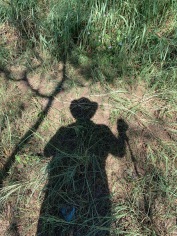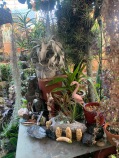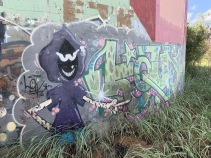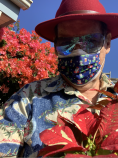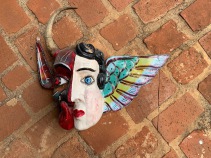A Brief Introduction to the Methods of Othor-Bionomy with an empnasis on Posistional Release (Phase 4)
Spontaneous Release by Positioning is the title of the paper, published 1964, in an osteopathic journal, that inspired the creation of Ortho-Bionomy. Arthur Lincoln Pauls read the paper during his training to become a doctor of osteopathy (DO) in the UK and the technique answered many questions for him and he developed it further. He eventually named his variation of the technique Phase 4. He named it this after arriving at what he came to call Phase 7.
Officially speaking, the training begins with Phase 4, and Phases 1, 2, and 3 are not part of the training, they are more or less imaginary. Pauls had various explanations of these mystery Phases. There is no particular reason why a student new to Ortho-Bionomy should begin with Phase 4 (as opposed to 5, 6, or 7, all of which Pauls referred to as “advanced” Ortho-Bionomy)
Instructors vary as to how they approach teaching the program. There is no set order to taking classes. Pauls often referred to the basic class material (Phase 4) as the “bread and butter” for a bodyworker and the most important part, for him, was what he called Phase 7. He would often say that one would not fully grasp Ortho-Bionomy without understanding Phase 7. He taught this class only by invitation and he had no prerequisites for who he would invite to learn it. Learning Phase 7 does not require any knowledge or experience of the other Phases.
In my teaching I consider Phase 7 to be part of the basics. It is equivalent to leaning good body mechanics. Thought by many to be a form of distance healing (which is how Pauls presented it) it is at the same time care of the self. Pauls’s spiritual training and grounding had him and the universe as one, all things connected. His was the same belief as the great Twentieth Century Spanish philosopher José Ortega y Gasset who famously wrote, “I am I and my circumstance; if I do not save it, I do not save myself.
Phase 7 is nothing more than a simple technique of visualization that allows one to move to a state of peace within in relation to some situation “outside,” such as another’s pain or suffering. It is a way to learn to practice compassion. It is the practice of compassion towards one’s self in relation to others. When practiced in this way there can be no such thing as “compassion fatigue.” This is a phrase that is called an oxymoron, containing two self contradictory terms.
As it is frequently taught that it is important to always be taking care of oneself while caring for others it is seldom taught that this very act of care of the self is the primary means of caring for others. With positional release techniques it is far more important to move within yourself to a compassionate stance than to be pristinely accurate in positioning a joint.
Positional Release Techniques are taught and practiced by a number of professional disciplines. They are relatively easy to learn, immediately relieve pain and tension in the subject, and if applied with a modicum of care and attention will not do any harm. At the very least they will do nothing (and sometimes nothing is exactly what is needed, “when nothing can be done, do Nothing”).
How It Is Done
Though often learned and employed by a variety of health care professionals, e.g., massage therapists and other bodyworkers, physical therapists, osteopaths and chiropractors, the vision that Pauls had when he set out teaching was to make this simple practice available to everyone, lay people, to provide simple and immediate care to family and friends: and orthobionomer in every household. This class is following that vision and is aimed primarily at lay practitioners. No detailed knowledge of anatomy is needed to be an effective practitioner. The anatomy you learned as a young child is sufficient: arm, neck, elbow, shoulder, leg, etc. is sufficient. Indeed, Pauls often found that the best students were young children.
The process involves locating a sore or tender point, usually within a muscle, or an area of tension, where the tissues feel hard under your touch. There is no rubbing or massaging or undue poking or probing. Once located all that is done with that is to hold a light contact to keep the attention there and feel for any change in tension. Initially you may not feel much but with a little practice you become more adept.
The next step is to move an associated joint into a position that reduces the tension around that point. It will be a position that shortens the muscle. It will be a position that the person it is being applied to will find comfortable. You may feel more comfortable within yourself when the other person’s joint is in a comfortable position. (An important aspect of Ortho-Bionomy is that it is reciprocal, both people feel benefit. This is because the two people form a system. If one part of a system changes the entire system changes. You will soon begin to experience that the boundaries between you and the other are not quite as clear as you may have thought. We are all connected.)
Once a comfortable position has been found the next step is a gentle compression into the joint, with a bit of rotation one way or another (compression with a twist). This “nails the landing,” so to speak. You will pause here for a few seconds for it to sink in and give the tissues a chance to reset themselves.
Then you will slowly release the pressure and do some gentle range of motion with the joint, allowing the person to experience improved mobility. You may recheck the tender area and usually will find the pain is either gone or significantly reduced.
The goal is always to find a way to “make a cave” around the tense or tender tissues. Karen Russell, in her novel Swamplandia, whose protagonist is a young woman who is learning to be an alligator wrestler in Florida, tells that when you kick an alligator the reptile’s reflexive response is to wrap around the boot. I like to imagine that this is the same ancient reflex we are dealing with. When we have an injury the body wants to fold around and protect where it hurts.
With practice you will learn to find a good position. You will also find that once in a position you can make tiny adjustments.
A common question is, how long do I hold the position? Lawrence Jones, the osteopath who wrote the original article, Spontaneous Release by Positioning, developed a system of Postitional Release Therapy he called Strain Counterstrain. This approach teaches to hold a position for 90 seconds. Timing then is externally imposed, clock time. By adding the “compression with a twist” you are in a position to simply notice when a response occurs. You can feel a gently pushing back, which we call “rebound.” You can move out of the position when you feel the rebound or (my preference) wait just a second or two, allowing this reflex to increase.
The experiencing Ortho-Bionomy, as a subject, most people are surprised because it feels like nothing is being done and pain vanishes as if by magic. Indeed, as a practitioner you are doing almost nothing. There is a motto in Ortho-Bionomy, Less is More. The idea is to do as little as possible; all you want to do is give the other person a little nudge, reminding the body of its own ability to return to balance, to heal.
The name Ortho-Bionomy was coined to mean “follow the natural laws of life.” The positioning that we do is a way of copying what the body does naturally when injured. Notice when you have an injury that the area around the injury gets held in a position that reduces pain and it holds it there so that healing of the tissues can occur.
Principles
There is often much said about the principles of Ortho-Bionomy. Mostly this is about the attitude you take as a practitioner, your state of mind. It may not seem that it would make a difference but it does.
- Non-attachment to outcome. This is not an easy state of mind to maintain. We all want good outcomes for the person we are wanting to help. It is relatively easy, however, to notice at any moment that you want something to happen. It is a recognizable state of tension within your body. When you become aware of it you can let it go. Practicing progressive relaxation can aid in this letting go of attachment to outcome.
- Presence. Simply being there, being present with another, is often the only thing that is needed, no other intervention. This can be a difficult lesson to learn as we have so often been taught that we are inadequate. Pauls stressed this often when teaching his cranial methods. A ‘simple’ matter of placing hands on certain positions then simply being present.
- Timing. Knowing the right timing is sort of like playing jump-rope as a child, knowing just when to come in. It’s not something you think about, you just do it. When you learn to be simply present (at one with) timing is a natural follow-on. Timing varies considerably with individuals. In general, changes can happen very quickly with infants and young children as well as with animals. Such critters can have little patience with hanging out too long in a position.
- Exaggerate the Lesion. I apologize for this language. Lesion is osteopathic jargon for any misalignment. The positions we find usually take the joint slightly further out of alignment.
- Move away from pain. It seems counterintuitive that “exaggerating the lesion” would be a move away from pain but this is what happens. This idea often gets misinterpreted as avoidance.
- Pattern disruption. It is held patterns of behavior, postures that were once necessary but no longer serve the situation that often lead to pain and dysfunction. Many of the methods of Ortho-Bionomy are meant to gently challenge and disrupt these old patterns, increasing the degrees of freedom.
- Be open. It can be surprising how healing shows up. Don’t insist on your own definition of what ‘healing’ is in any given situation.
- Changes often happen over time. Be satisfied with a small improvement. Pauls and an early associate he developed these methods with first called it “”Phased Reflex Techniques” because they observed that improvements happened over several days. You only give it a little nudge to get things started.
- Learned Ignorance (Non-Hierarchical). You are not the expert. I have borrowed the phase “learned ignorance” from the Fifteenth Century philosopher, theologian, jurist, mathematician and astronomer, Nicholas of Cusa. He was one of the first German proponents of Renaissance humanism. Unless you happen to be a licensed physician your role is not to diagnose or have any special knowledge or insight. You are simply being and moving with another person and you have a bit of skill. This is not a “power over” relationship but “power with.” Learn to be comfortable saying “I don’t know,” especially when you think you do.
- Less is more, Doing Nothing. We always strive to apply the minimum amount of effort and rely on self-corrective reflexes in the other.
- Reciprocity. Find yourself by going out, find the other by going in. Doing Ortho-Bionomy does not drain one’s energy but recharges.
- Movement is our ground of being. Change is constant. Movement is bidirectional.
- “The event has already occurred, you are only performing the ritual.” Arthur Lincoln Pauls.
Other Phases of Ortho-Bionomy
It is difficult to teach the positional release portion of Ortho-Bionomy without mention of the next ‘Phase,’ which I refer to as Haptics. Haptics has to do with perception and communication through touch and proprioception (mostly below conscious threshold). The next ‘discovery” Pauls made was that the person’s body could guide him into the best position, it would seem to just naturally go there. It often feels like there is a shift in mood and then the practitioner is following and facilitating a movement, not initiating it. Often you can simply think about where the position might be and then the movement happens. We will likely include this in this basic class, even though it is said to be ‘advanced.’
Phase 6 involves working off the body but in proximity. Some refer to it as ‘aura work work but I don’t care for that word without considerable explanation. It is also sometimes referred to as ‘energy medicine’ or ‘energy work,’ terms I also avoid using because I am convinced it does not involve any sort of exchange of ‘energy’ but information. You may call it what you want. We may include a bit of this. It is useful at this level in finding a place to start a session, finding a way in, getting yourself in sync with another.
Other aspects of the Ortho-Bionomy training program will be briefly addressed, depending on time. They may include: Isometrics, Chapman’s Reflex Network, Exploration of Movement Patterns, Posture and Post-Techniques.
